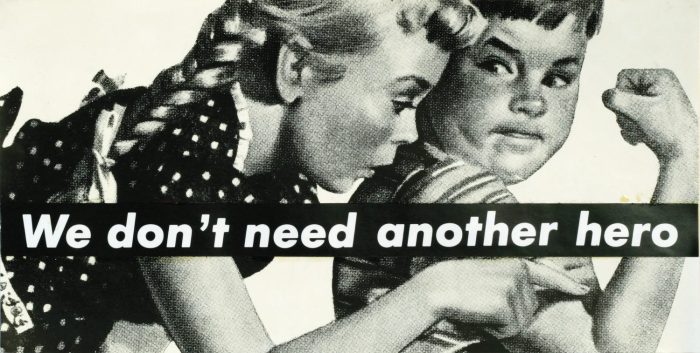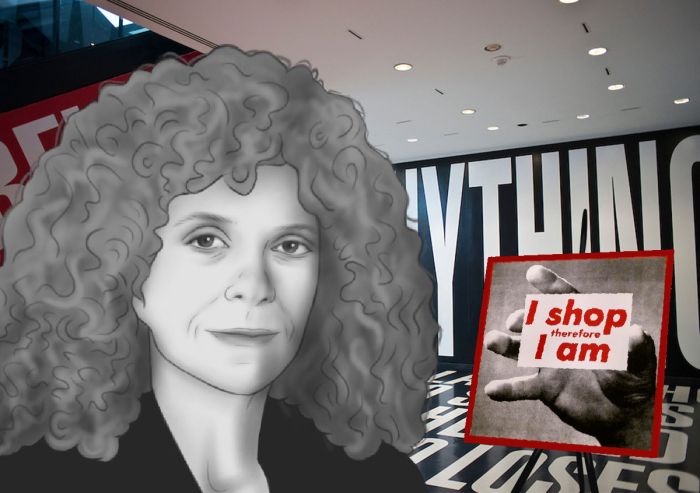Barbara kruger we don’t need another hero – Barbara Kruger’s iconic artwork, ‘We Don’t Need Another Hero,’ stands as a powerful critique of societal norms, challenging traditional notions of heroism and masculinity while empowering women and feminist discourse. This essay delves into the multifaceted layers of Kruger’s creation, exploring its artistic elements, sociopolitical commentary, feminist perspective, cultural impact, and enduring legacy.
Kruger’s work is a visual symphony of bold typography, striking imagery, and thought-provoking slogans that confront viewers with uncomfortable truths. Her strategic use of black and white, combined with the confrontational nature of her messages, creates a visceral impact that demands attention and reflection.
Contextual Overview of “We Don’t Need Another Hero”: Barbara Kruger We Don’t Need Another Hero

Barbara Kruger’s “We Don’t Need Another Hero” is an iconic artwork that emerged in the early 1980s. It originated as part of a series of posters and photomontages that challenged prevailing societal norms and celebrated feminist perspectives. The artwork gained widespread recognition and resonated deeply with the cultural and historical context of its time, which was characterized by a growing awareness of social and political issues, particularly those concerning gender roles and inequalities.
Intended Message and Purpose
Kruger intended “We Don’t Need Another Hero” to be a critique of traditional notions of heroism and masculinity, which she saw as limiting and oppressive. Through the artwork, she sought to challenge the idea that only men could be heroes and that women were relegated to passive or supportive roles.
Kruger aimed to empower women by encouraging them to question societal expectations and embrace their own strength and agency.
Artistic Elements and Techniques

The artwork consists of a black-and-white photograph of a young woman’s face, overlaid with bold red text that reads “We Don’t Need Another Hero.” The photograph is taken from a slightly tilted angle, giving the viewer a sense of intimacy and vulnerability.
The red text, printed in Kruger’s signature Futura Bold font, contrasts sharply with the black-and-white background, creating a sense of urgency and demanding attention.
Symbolism and Metaphors
Kruger’s use of symbolism and metaphors adds depth and complexity to the artwork. The young woman’s face represents both the strength and vulnerability of women, while the red text symbolizes both the anger and defiance that women often feel in response to societal expectations.
The tilted angle of the photograph suggests that the viewer is looking up at the woman, emphasizing her strength and resilience.
Sociopolitical Commentary
“We Don’t Need Another Hero” serves as a powerful critique of societal norms and expectations. Kruger challenges traditional notions of heroism, which often glorify violence and aggression, and instead suggests that true heroism lies in challenging injustice and fighting for equality.
The artwork also challenges traditional gender roles, arguing that women are just as capable as men of being leaders and heroes.
Relevance to Contemporary Issues, Barbara kruger we don’t need another hero
The artwork remains relevant to contemporary social and political issues. It continues to resonate with audiences who are concerned about gender inequality, violence against women, and the need for social change. Kruger’s message is particularly poignant in light of recent movements such as #MeToo and #TimesUp, which have brought renewed attention to the issues of sexual harassment and assault.
Feminist Perspective
“We Don’t Need Another Hero” is a powerful feminist statement. It challenges patriarchal structures that have traditionally marginalized women and empowers women to embrace their own strength and agency. Kruger’s use of a young woman’s face as the central image emphasizes the importance of women’s voices and perspectives.
Impact on the Feminist Movement
The artwork has had a significant impact on the feminist movement and its representation in art. It has become an iconic symbol of feminist resistance and empowerment, and has been used in countless protests and campaigns. Kruger’s work has inspired other feminist artists and activists, and has helped to shape the way that women are represented in contemporary art.
Cultural Impact and Legacy

“We Don’t Need Another Hero” has had a profound impact on popular culture and society. It has been featured in countless books, articles, and exhibitions, and has been referenced in music, film, and television. The artwork has become a symbol of feminist resistance and empowerment, and has inspired countless individuals to challenge societal norms and fight for equality.
Enduring Impact on Art and Activism
Kruger’s work continues to be influential in contemporary art and activism. Her bold and provocative style has inspired other artists to use their work to challenge social and political injustices. Kruger’s message of empowerment and resistance remains relevant today, and her work continues to inspire activists and artists around the world.
FAQ Section
What is the central message conveyed in ‘We Don’t Need Another Hero’?
Kruger’s artwork critiques the glorification of traditional masculinity, emphasizing the need for a more inclusive and diverse representation of heroism.
How does Kruger’s use of typography contribute to the impact of the artwork?
Kruger’s bold and confrontational typography forces viewers to confront the messages embedded within her images, creating a sense of urgency and demand for attention.
What is the significance of the artwork’s feminist perspective?
Kruger’s work challenges patriarchal structures, empowers women, and encourages a critical examination of gender roles and expectations.